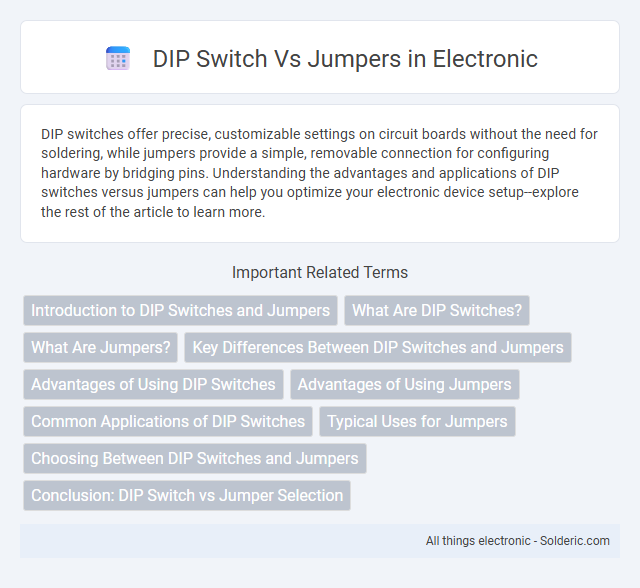DIP switches offer precise, customizable settings on circuit boards without the need for soldering, while jumpers provide a simple, removable connection for configuring hardware by bridging pins. Understanding the advantages and applications of DIP switches versus jumpers can help you optimize your electronic device setup--explore the rest of the article to learn more.
Comparison Table
| Feature | DIP Switch | Jumpers |
|---|---|---|
| Definition | Small manual electric switches in a dual inline package | Small connectors used to close or open circuit pins on a PCB |
| Usage | Configure device settings like modes, addresses | Set hardware options by connecting pins for circuit configurations |
| Form Factor | Inline switch array, usually 4-12 switches | Two or three-pin shunts fitted over pins |
| Adjustment Method | Flip switches ON/OFF | Move jumper shunt to connect specific pins |
| Reusability | Multiple uses, easily reset | Reusable but can be misplaced or lost |
| Size | Compact, low-profile | Small, discrete connectors |
| Typical Applications | Setting device addresses, modes in computers and electronics | PCB configuration, BIOS settings, hardware selection |
| Common Advantage | Easy visual identification of settings | Simple circuit configuration without soldering |
Introduction to DIP Switches and Jumpers
DIP switches and jumpers are essential components used for configuring hardware settings on electronic devices. DIP switches consist of a series of small toggles that can be set to ON or OFF positions, allowing multiple binary options, while jumpers are small connectors placed over pairs of pins to complete or break electrical circuits. Understanding the functional differences between DIP switches and jumpers helps you select the appropriate method for customizing device behavior with precision and ease.
What Are DIP Switches?
DIP switches are compact, manual electronic devices used to configure settings on circuit boards by toggling small switches on or off. These switches provide a reliable way to customize hardware functions without needing programming or software, making them ideal for system configurations and hardware troubleshooting. Understanding DIP switches helps you easily control device options and modify functionality in embedded systems or electronic gadgets.
What Are Jumpers?
Jumpers are small connectors used on printed circuit boards (PCBs) to configure hardware settings by closing or opening electrical circuits. They function by bridging two pins on a header to establish specific device modes or settings, such as BIOS configurations or voltage selections. You can change system functions easily by repositioning jumpers without the need for soldering or complex tools.
Key Differences Between DIP Switches and Jumpers
DIP switches and jumpers both serve as hardware configuration tools but differ significantly in design and functionality. DIP switches are small, manual switches that allow multiple binary settings on a single component, enabling easy on/off configurations without removing components. Jumpers require physically placing a small connector on pins to create or break circuits, making them less flexible but often simpler for single on/off selections. Your choice depends on whether you need quick multi-setting adjustments (DIP switches) or straightforward, secure connections (jumpers).
Advantages of Using DIP Switches
DIP switches offer precise control and easy configuration changes without soldering, making them ideal for hardware settings and customization. They provide a reliable and durable solution for setting device parameters, reducing the risk of accidental changes compared to jumpers. Their compact design enables efficient space utilization on printed circuit boards, enhancing overall device integration.
Advantages of Using Jumpers
Jumpers offer a simple and reliable method for configuring hardware settings due to their secure physical connection, reducing the risk of accidental changes compared to DIP switches. They require minimal space on circuit boards, making them ideal for compact designs and straightforward installation. The clear on/off state of jumpers enhances troubleshooting and maintenance by providing immediate visual confirmation of configuration.
Common Applications of DIP Switches
DIP switches are commonly used in electronic devices for setting configurations such as device addresses, system modes, and feature options in hardware without requiring software intervention. They are prevalent in applications like communication equipment, industrial machinery, and consumer electronics, offering reliable, manual control for customization. Your system's adaptability can be enhanced by utilizing DIP switches where precise, user-configurable settings are essential.
Typical Uses for Jumpers
Jumpers are commonly used on motherboards and hard drives to configure hardware settings such as enabling or disabling features, setting device IDs, or selecting operational modes. They provide a straightforward method for hardware customization without software intervention, often found in older computer components or industrial equipment. Jumpers allow technicians and users to quickly alter hardware configurations, making them essential for BIOS settings, drive configurations, and legacy system maintenance.
Choosing Between DIP Switches and Jumpers
Choosing between DIP switches and jumpers depends on the desired ease of configuration and frequency of changes. DIP switches offer quick, tool-free settings ideal for frequent adjustments, while jumpers provide a more secure connection better suited for infrequent changes. Evaluating the application environment and user access needs ensures optimal selection for reliable device configuration.
Conclusion: DIP Switch vs Jumper Selection
DIP switches offer precise, easily modifiable settings without the need for physical tools, ideal for complex or frequent configuration changes. Jumpers provide a simple, cost-effective solution for basic, less frequently changed settings but require manual repositioning with tools. Selecting between DIP switches and jumpers depends on the required frequency of adjustments, ease of access, and complexity of configuration in the electronic device.
DIP switch vs jumpers Infographic

 solderic.com
solderic.com